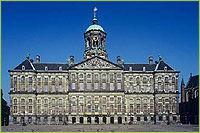| |
 |
|
Royal Palace
The Royal Palace of Amsterdam is situated on Dam Square in the centre of Amsterdam.
It was originally built as the city hall for the magistrates of Amsterdam. In the 17-th
century it was the largest secular building of Europe.
The Royal Palace on the Dam is one of the three Palaces which the State has placed at
the Queen's disposal by Act of Parliament. It is used mainly for official state functions,
for example state visits, the Queen's New Year reception and other official receptions.
Every year, it provides the setting for the presentation of various official and royal prizes.
History
The celebrated architect Jacob van Campen, took control of the building-project in 1648.
The entire building was constructed of white stone, though the weathering of the centuries
has left none of it visible. On 20 July 1655, the burgomasters and the magistrates
opened the first section. The Royal Palace is famous for it's rich and imposing decorations. Renowned sculptors were brought to Amsterdam and famous painters such as Rembrandt
and Ferdinand Bol contributed to the interior. The central theme, featuring in much of
the decoration, was the power of Amsterdam in particular and the Dutch Republic in
general. The building served as the city hall for a century and a half.
In 1806, the Batavian Republic was forced to accept Louis Napoleon, the brother of the
French Emperor, as the King of Holland. Louis Napoleon originally opted to live in
The Hague, but in 1807 he decided to move to Amsterdam. In 1808, he took possession
of the city hall and conversed it to a Royal Palace with decoration in the Empire style.
Visitors of the Royal Palace can still visit the famous collection of Empire furniture bought
by Louis Napoleon.
On the fall of Emperor Napoleon in 1813, Prince William, later King William I, returned
the Palace to the city of Amsterdam. However, after his investiture, the new King realised
the importance of having a home in the capital, and asked the city authorities to make
the Palace available to him once again. It was not until 1936 that it became state property.
|

